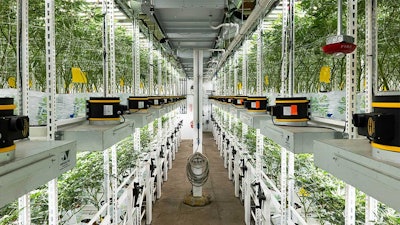
When it comes to cultivating cannabis in California’s incredibly competitive licensed market, Oakfruitland’s owner and CEO, Linzi, is laser focused on two things: quality and affordability.
While those goals seem straightforward, achieving them was neither simple nor fast. Oakfruitland, an Oakland-based cultivation company founded in 2019 as a single level, indoor facility, first produced cannabis for other brands and white labeled its products. In 2021, the company shifted to focus on developing and elevating its own brand.
Securing shelf space at dispensaries is just one hurdle brands face in the largest cannabis market in the U.S. As of Aug. 9, there were 6,101 licensed cultivation companies supplying 1,216 retailers, according to data from California’s Department of Cannabis Control. Although the balance has improved in the past few years – in May 2022, there were only 948 retailers for about 7,700 cultivators – many operators have struggled to stay afloat amid falling wholesale prices, competition from the illicit market and hefty tax bills.
And total average monthly sales in California are down 6% year over year from 2022 to 2023. But despite the market realities, Oakfruitland has found its groove.
“We’re doing really good in retail sales because of our prices, and there's no competition out there for the quality we put out,” Linzi says, adding that Oakfruitland’s products can be found in 120 dispensaries in the state. “It is really hard at this moment for a lot of brands to step out because of the competition and the oversupply issue. So that's why we're going on a strategy that we want it to be an affordable brand with high quality.”


Oakfruitland's owner and CEO says converting to tiered growing powered by Fluence LEDs has helped them survive the market downturn in California and focus on the company's five-year plan. Photo courtesy of Fluence.
But Linzi says by focusing on optimizing production and investing in the most important areas of cultivation, she’s confident Oakfruitland will continue to thrive despite volatile conditions.
The facility was built as a single tier grow, but as Linzi and the team saw price compression intensify, they started making plans to move to tiered growing. The first step was investigating and trialing the best lights for the job. It was a large expense—they needed 2,400 lights to outfit their grow— and Linzi wanted to be sure she had the most effective LEDs. Oakfruitland is self-funded, and Linzi reinvests profits back into the company.
“I make sure every dollar is well spent,” she says. Capital for improvements is saved “product by product, batch by batch.”
In 2021, after spending months exploring various LED manufacturers, Oakfruitland experimented with five different brands and thoroughly researched each company, including Fluence. They conducted side-by-side comparisons, and Linzi says that although the Fluence LEDs were more expensive than some, it was worth the money, as they performed the best by far.
“Fluence has the technology behind it, and they’re willing to work with growers,” Linzi says, adding that the customer service and technology experts supported them throughout the entire process. “A lot of people are stuck in their comfort zone and don’t want to try [LEDs] because they don't think that it will [impact yield or quality] but we can see the results. Plants are healthier and less vulnerable. The end product is denser, and the color looks nicer, and it's much more frosty—and that’s what people are looking for right now.”

Oakfruitland, based in Oakland, Calif., invested in 2,400 LEDs to move to vertical growing. Photo courtesy of Fluence.
When compared with other LEDs, Linzi says the plants grown under Fluence lights had better trichome development and finished better. Today, Oakfruitland uses a variety of LED lights from Fluence, including the SPYDR 2x, 2i and 2h.
“And then once you smoke it, you see the difference immediately,” she adds.
Converting from double-ended HPS to double-tiered growing was not as complicated as anticipated because of the resources Fluence offered the Oakfruitland team and the way the company adapts to market changes. Speed in retrofitting the facility was crucial so that Oakfruitland would not lose precious growing time.
“When we didn’t have the right accessory to hang the lights, Fluence was able to create something more quickly than other competitors,” Linzi says. “We could get exactly the kind of hook we needed to adapt to the double-tier system, which other brands took much longer to do.
“Fluence takes so much time to look at what growers want instead of just putting out product. They start with our needs, then design it and put it into production.”
In an industry as unpredictable but as rewarding as cannabis, Linzi says she wanted to be sure she found a lighting partner in it for the long haul.
“We only wanted to work with a company who wants to improve, and it's rare to find,” she says. “I'm the type of person that I'd rather invest heavier in the beginning to ensure that this goes a long way instead of paying less and not knowing if this particular product would last us for two years.”
With patience, persistence and supportive vendors, Linzi is confident Oakfruitland will continue to succeed.
“We’re still making good margins in this industry,” she says. “You just need to keep your head down and keep on working. And have that foresight to make those investments that will really make the difference moving forward. If you can survive during the hard times like this, then you will succeed in the next five years.”
